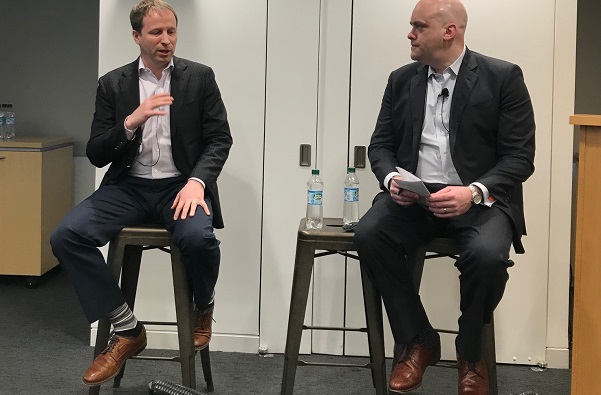 Left Nathan Rogers; Right Brian Watson
Left Nathan Rogers; Right Brian Watson
Washington, DC—It is widely known that corporate real estate was one of the last industries bitten by the technology bug. Now though, It's become such a part of the landscape that decision makers are eager to embrace machine learning, mobile apps, artificial technology plus a myriad of smart technologies that can enhance work environments. Industry experts explored these topics at last week's second annual CoreNet Global Mid-Atlantic CRE Technology Symposium.
“After our first CRE Technology Symposium last year, we observed an interest in going deeper into consumer experience of the tech applications,” said Peter Van Emburgh, Global Director, Corporate Workplace and Facilities at CBRE and the organizer of the symposium. “Last year's event was about the prop tech landscape, and this year we focused on the human element, and how you make the technology work for people.”
The Employee Experience
One of the symposium's hot topics was how the convergence of real estate, the workplace and technology has positively impacted the employee experience.
“The increasing demand for talent is forcing corporate real estate to think of the workplace as an investment to leverage, rather than the traditional notion of offices as an expense to manage. Through technology, CRE is creating an improved employee experience that is helping companies to foster cultures of creativity and innovation,” says Scott Phillips, Director of Corporate Real Estate at McDonalds Corporation.
“Apps like Comfy that allow employees to have a direct effect on the temperature in their portion of the office and Transit Screen that provides real time commute transportation information are bringing a level of comfort, convenience and ease of use that are allowing employees to be more engaged than ever.”
Adding Cyber Security to the Mix
Cybersecurity and its related expenses are also another concern by employers, especially as more employees work from home or via mobile apps.
“Cyber threats are becoming more sophisticated and attacks are increasing daily. Organizations need to find ways to protect their assets and data, while at the same time balancing employee and customer experiences,” said Nathan Rogers, Senior Vice President and Chief Information Officer, SAIC. “All of this needs to be done within tight budgets.”
CISOs and CIOs have to be creative and thoughtful as they tackle cyber security challenges, Rogers continued. “In 2019, we need to find effective ways to train our employees, implement best of breed tools that incorporate automation and machine learning and partner with organizations that can help implement best practices.”
Just as significantly they need to be hyper aware of the tech challenges involved. “All of the solutions we've been talking about, any kind of workplace solutions technology involves integrating with multiple systems,” said Chris Fine, Senior Strategist Smart Spaces and Iota, Aruba Networks. “It's never just one thing. You also have to think about what data you're collecting, where you're going to keep it, how to avoid collecting personally identifiable information. What are you tracking? What are you expecting people to supply.
“You really don't want to be on the wrong side of cybersecurity.”
CRE-Focused Tech
Of course, the symposium also addressed the vast amounts of technology and information that is solely focused on the commercial estate sector.
“There certainly has been an explosion of new technological capabilities in the workplace, and that's a great thing. To harness these opportunities, executives in technology, facilities, HR and operations, to name a few, need to form strong partnerships to determine where their companies will get the most value from these technologies,” said Brian P. Watson, Author and Vice President, Traction Technology Partners. Then they must develop sophisticated processes for discovering, vetting and sourcing the technologies that will make the biggest impact, he added.
Watson also pointed out the numerous case studies of companies that have improved collaboration, productivity, and employee satisfaction by deploying the right tools. “Given the glut of options available, its not always an easy task thus strong prioritization and evaluation are critical.”
© Touchpoint Markets, All Rights Reserved. Request academic re-use from www.copyright.com. All other uses, submit a request to [email protected]. For more inforrmation visit Asset & Logo Licensing.






